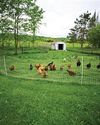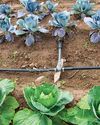
Certain insects are emerging off of their usual schedules, too. The result? Potentially significant disruptions to the life cycles of some of our most industrious pollinators and a decoupling of critical plant-and-pollinator relationships.
“The plants and the insects are responding to different phenological cues,” says Daniel Herms. Formerly a professor and department chair at The Ohio State University Department of Entomology, Herms presently works as vice president of research and development for the Davey Tree Expert Co. He has been monitoring phenological events — natural occurrences synchronized to the weather and the seasons — for nearly 40 years.
“[Plants and insects] respond to temperature differently,” Herms says. “They’re in different niches, and each niche is being affected differently by climate change.”
Generalists vs. Specialists
In part, that degree of impact depends on the relationships insects have with the plants on which they rely. For instance, moths and butterflies tend to be generalists when it comes to their nectar sources. This makes them less susceptible to missed windows of opportunity with specific flowering plants.
“If they’re mismatched with one nectar plant, well, then they just go over to a different nectar plant,” Herms says. (That said, though, they are much more limited in terms of the host plants on which they’ll lay their eggs.)
この記事は Hobby Farms の May - June 2023 版に掲載されています。
7 日間の Magzter GOLD 無料トライアルを開始して、何千もの厳選されたプレミアム ストーリー、8,500 以上の雑誌や新聞にアクセスしてください。
すでに購読者です ? サインイン
この記事は Hobby Farms の May - June 2023 版に掲載されています。
7 日間の Magzter GOLD 無料トライアルを開始して、何千もの厳選されたプレミアム ストーリー、8,500 以上の雑誌や新聞にアクセスしてください。
すでに購読者です? サインイン

Meet Holly Callahan-Kasmala & Chrisie DiCarlo
In Maryland, best friends of 40-plus years share a passion for good food, laughter and, most of all, poultry.

HISTORIC Hogs
The Hereford breed has a bright future.

ON TRACK
Animal activity trackers, also known as pet location trackers, let you keep an eye on your pets or livestock from your phone or computer.

ELECTRIC BORDERS
Here's what you need to know before you buy a portable electric fence.

beyond TRADITION
Raise these alternative animals on your hobby farm.

Sheep HOOF CARE
The key to good sheep hoof care is keeping an eye out for problems and moving to prevent serious issues.

Santa Carota BEEF
For 35 years, the Pettit family has been upcycling waste carrots for cattle feed, challenging traditional ranching practices while producing exquisite beef.

Metabolic Disorders in Cattle
Manage these body conditions in your herd with diagnosis, treatment and prevention.

Midsummer Garden
Keep those vegetables growing late into the year with these planting options and advice.

Microclimate Trouble Spots
Spend enough time gardening in one place and you can get to know it well.